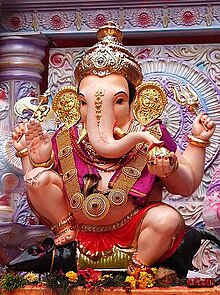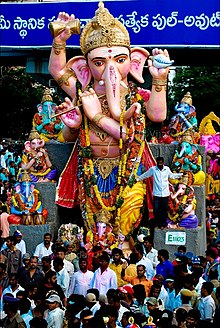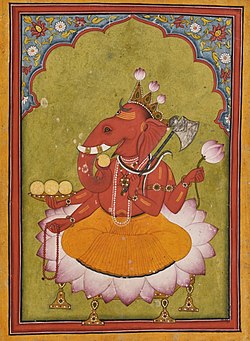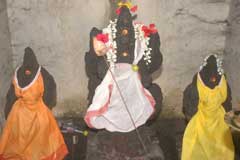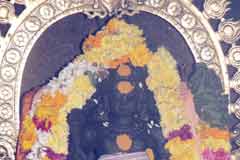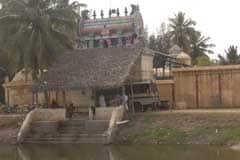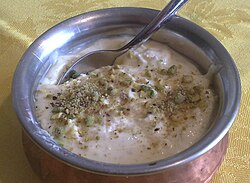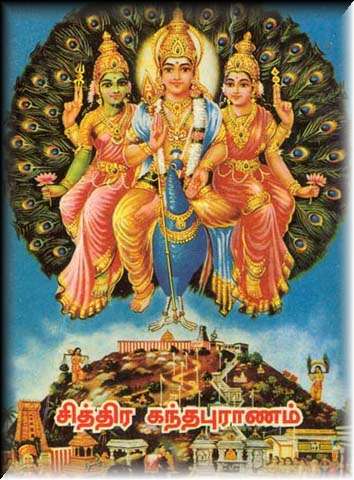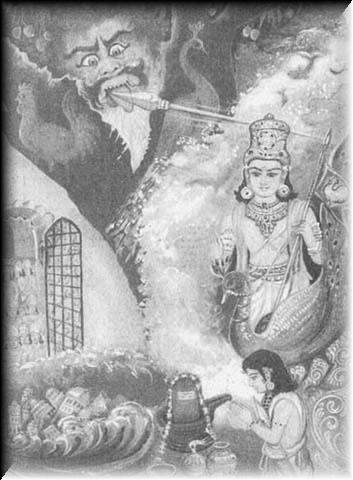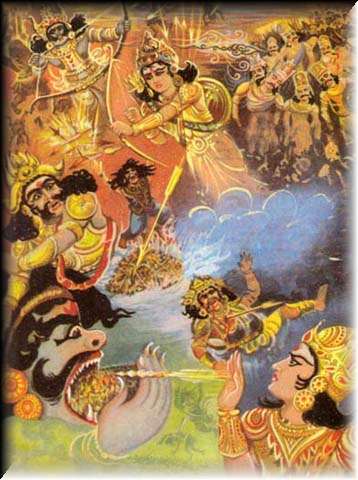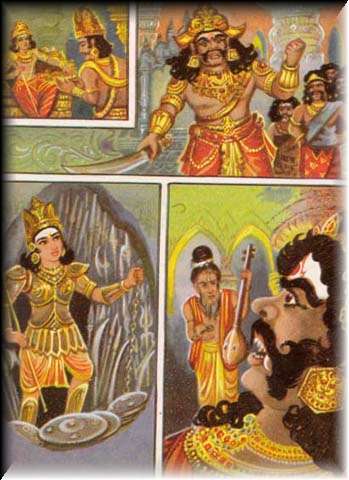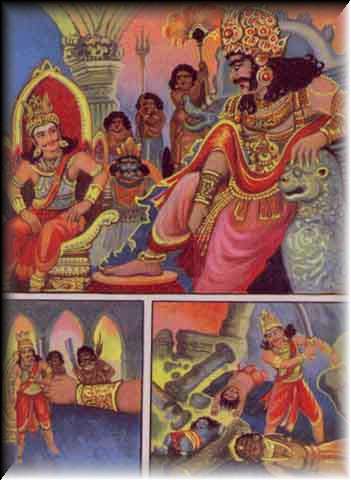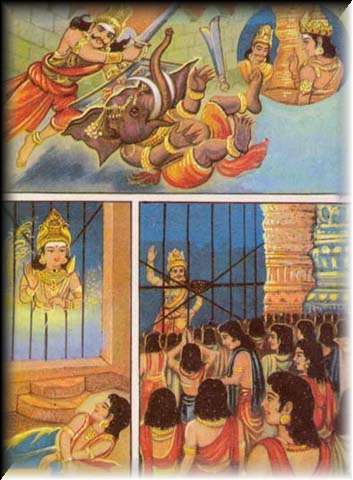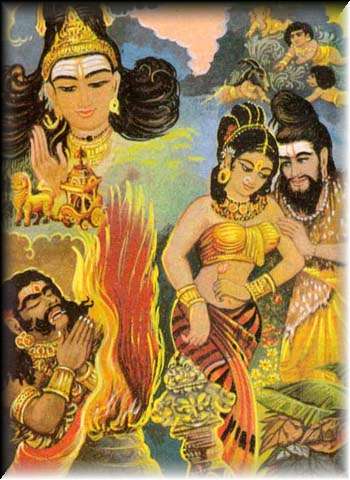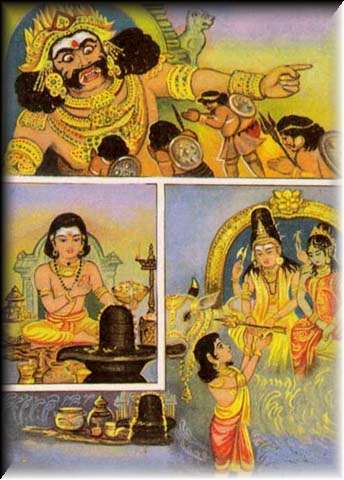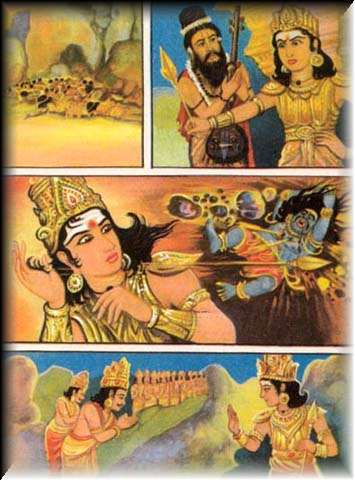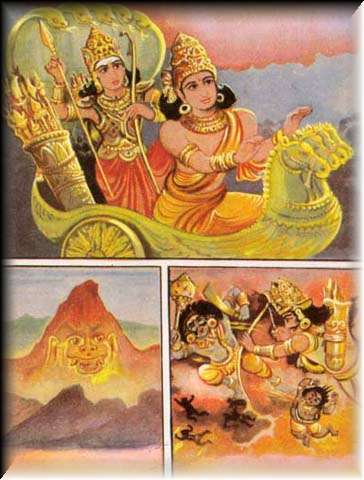Saturday 30 June 2012
GANESHA
Für jene Gläubigen, die in Ganesha oder Ganapati das Höchste sehen, ist Ganesh Chaturthi (nach dem Mondkalender zwischen Mitte August und Mitte September) das höchste aller Feste im Jahreslauf; nach ihrem Glauben kommt Gott in diesen Tagen zu Besuch.
Besonders prächtig feiern die Menschen den Tag in Mumbai (früher Bombay). Dabei werden unzählige kleine oder riesige Ganesh-Statuen aus Lehm auf Altären in Häusern und Straßen aufgestellt und einige Tage verehren die Gläubigen in diesen Darstellungen das Göttliche mit regelmäßigen Gottesdiensten, Musik und Tanz. Am letzten Tag werden sie verabschiedet und in fröhlichen Prozessionen zum Meer gebracht, wo man sie unter Jubel in den Fluten versenkt
Ganesha in German
Tanzender Ganesha, Nordbengalen, 11. Jahrhundert. Museum für Asiatische Kunst, Berlin-Dahlem.
Ikonographie
Meist wird Ganesha dargestellt als roter, beleibter Mann oder als Kind mit einem Elefantenkopf, der nur einen Stoßzahn hat, oft auf einer Lotusblüte sitzend. Bei ihm ist immer sein Reittier, eine Maus oder Ratte, die ebenfalls unter anderem Symbol für Intelligenz und Stärke ist.
Seine vier Arme sind in der hinduistischen Kosmologie u. a. ein Zeichen von Virtuosität, von überlegener (göttlicher) Macht.
Sie tragen in traditionellen Darstellungen eine Waffe u. a. als Zeichen des Schutzes und seines Kampfes gegen alles Übel, eine Lotusblüte, u. a. Zeichen der geistigen Wiedergeburt, Weisheit und Reinheit, Reinkarnation (Wiedergeburt). Auf anderen Darstellungen trägt er ein Buch sowie eine Mala, eine Gebetskette. Seinen zweiten Stoßzahn verlor er der Legende nach im Kampf gegen Parashurama (Rama-mit-der-Axt), Vishnus sechste Inkarnation. Seine anderen beiden Hände signalisieren dem Gläubigen in bestimmten Handstellungen Mudras: Fürchte dich nicht! (trostspendende Mudra) und versprechen in der gebenden Geste seine Gnade. Meist steht eine Schale mit kugelrunden Laddus vor ihm, das sind spezielle Süßigkeiten, die neben vielschichtiger spiritueller Bedeutung Ganeshas Liebe zum Essen darstellen.
Rätselhaft erscheint Ganeshas Mischform aus Mensch und Elefant. Am ehesten verständlich ist sie über den Elefanten, ein wichtiges Symboltier, in der Mythologie Wächter und Träger des Alls. In der gesamten hinduistischen Symbolik erscheinen Elefanten und Ganesha abwechselnd, z. B. als Glückszeichen und Hüter an Wohnhäusern ebenso wie an Tempeln. Verbreitet ist auch die Erklärung des Kopfes als Zeichen für den Makrokosmos und der menschliche Körper als Mikrokosmos.
GANESHA
Ganesha (Sanskrit: गणेश Gaṇeśa ) (Gana: ‚Gefolge‘, ‚Schar‘, Isha: ‚Herr‘ , also „Herr der Scharen“) ist eine der beliebtesten Formen des Göttlichen im Hinduismus. Weitere verbreitete Namen sind unter anderem Ganapati (‚Gebieter der Scharen‘), Vinayaka (‚Entferner [der Hindernisse]‘) und Vighnesha (‚Herr der Hindernisse‘).
Jede Puja (hinduistischer Gottesdienst) beginnt mit einem Gebet an ihn. Er wird angebetet, wenn man Glück für den Weg oder eine Unternehmung braucht, er steht für jeden Neuanfang und verkörpert Weisheit und Intelligenz. Zu seinen Angelegenheiten gehören die Poesie, Musik und Tanz und er ist der Herr über die Wissenschaften. Die meisten Kaufleute betrachten ihn als ihren Schutzherrn. Für viele fromme Hindus ist das erste, was in ein neues Haus kommt, eine Statue des Ganesha. Diese segnet das Haus und verheißt Glück.
Für viele hinduistische Strömungen bedeutet Ganesha eine untergeordnete Manifestation des Göttlichen, der Herr allen Anfangs. Andere dagegen, besonders im indischen Bundesstaat Maharashtra oder in einigen Gegenden Südindiens, sehen in ihm die wichtigste Verkörperung des formlosen Höchsten, des Brahman.
GANESHA
Etymology and other names
Ganesha has many other titles and epithets, including Ganapati and Vighneshvara. The Hindu title of respect Shri (Sanskrit: श्री; IAST: śrī; also spelled Sri or Shree) is often added before his name. One popular way Ganesha is worshipped is by chanting a Ganesha Sahasranama, a litany of "a thousand names of Ganesha". Each name in the sahasranama conveys a different meaning and symbolises a different aspect of Ganesha. At least two different versions of the Ganesha Sahasranama exist; one version is drawn from the Ganesha Purana, a Hindu scripture venerating Ganesha.
The name Ganesha is a Sanskrit compound, joining the words gana (Sanskrit: गण; IAST: gaṇa), meaning a group, multitude, or categorical system and isha(Sanskrit: ईश; IAST: īśa), meaning lord or master.. The word gaņa when associated with Ganesha is often taken to refer to the gaņas, a troop of semi-divine beings that form part of the retinue of Shiva (IAST: Śiva).The term more generally means a category, class, community, association, or corporation. Some commentators interpret the name "Lord of the Gaņas" to mean "Lord of Hosts" or "Lord of created categories", such as the elements. Ganapati (Sanskrit: गणपति; IAST: gaṇapati), a synonym for Ganesha, is a compound composed of gaṇa, meaning "group", and pati, meaning "ruler" or "lord". The Amarakosha,an early Sanskrit lexicon, lists eight synonyms of Ganesha : Vinayaka, Vighnarāja (equivalent to Vignesha), Dvaimātura (one who has two mothers),Gaṇādhipa(equivalent to Ganapati and Ganesha), Ekadanta (one who has one tusk), Heramba, Lambodara (one who has a pot belly, or, literally, one who has a hanging belly), and Gajanana (IAST: gajānana); having the face of an elephant).
Vinayaka (Sanskrit: विनायक; IAST: vināyaka) is a common name for Ganesha that appears in the Purāṇas and in Buddhist Tantras. This name is reflected in the naming of the eight famous Ganesha temples in Maharashtra known as the Ashtavinayak (aṣṭavināyaka).The names Vighnesha (Sanskrit: विघ्नेश; IAST:vighneśa) and Vighneshvara (Sanskrit: विघ्नेश्वर; vighneśvara) (Lord of Obstacles) refers to his primary function in Hindu mythology as the master and remover of obstacles (vighna).
A prominent name for Ganesha in the Tamil language is Pille (Little Child). A. K. Narain differentiates these terms by saying that pille means a "child" while pillaiyar means a "noble child". He adds that the words pallu, pella, and pell in the Dravidian family of languages signify "tooth or tusk", also "elephant tooth or tusk". Anita Raina Thapan notes that the root word pille in the name Pillaiyar might have originally meant "the young of the elephant", because the Pali word pillakameans "a young elephant".
Street festivities in Hyderabad, Indiaduring the festival of Ganesh Chaturthi
In the Burmese language, Ganesha is known as Maha Peinne, derived from Pali Mahā Wināyaka.The widespread name of Ganesha inThailand is Phra Phikanet or Phra Phikanesuan, both of which are derived from Vara Vighnesha and Vara Vighneshvara respectively, whereas the name Kanet (from Ganesha) is rather rare.
Ganesh Chaturthi :: The festival
GANESHA
How to celebrate the great Ganesha festival.
Ganesha Chaturthi, the great Ganesha festival, also known as 'Vinayak Chaturthi' or 'Vinayaka Chavithi' is celebrated by Hindus around the world as the birthday of Lord Ganesha. It is observed during the Hindu month of Bhadra (mid-August to mid-September) and the grandest and most elaborate of them, especially in the western India state of Maharashtra, lasts for 10 days, ending on the day of 'Ananta Chaturdashi'.
The Grand Celebration
A life-like clay model of Lord Ganesha is made 2-3 months prior to the day of Ganesh Chaturthi. The size of this idol may vary from 3/4th of an inch to over 25 feet.
On the day of the festival, it is placed on raised platforms in homes or in elaborately decorated outdoor tents for people to view and pay their homage. The priest, usually clad in red silk dhoti and shawl, then invokes life into the idol amidst the chanting of mantras. This ritual is called 'pranapratishhtha'. After this the 'shhodashopachara' (16 ways of paying tribute) follows. Coconut, jaggery, 21 'modakas' (rice flour preparation), 21 'durva' (trefoil) blades and red flowers are offered. The idol is anointed with red unguent or sandal paste (rakta chandan). Throughout the ceremony, Vedic hymns from the Rig Veda and Ganapati Atharva Shirsha Upanishad, and Ganesha stotra from the Narada Purana are chanted.
For 10 days, from Bhadrapad Shudh Chaturthi to the Ananta Chaturdashi, Ganesha is worshipped. On the 11th day, the image is taken through the streets in a procession accompanied with dancing, singing, to be immersed in a river or the sea symbolizing a ritual see-off of the Lord in his journey towards his abode in Kailash while taking away with him the misfortunes of all man. All join in this final procession shouting "Ganapathi Bappa Morya, Purchya Varshi Laukariya" (O father Ganesha, come again early next year). After the final offering of coconuts, flowers and camphor is made, people carry the idol to the river to immerse it.
The whole community comes to worship Ganesha in beautifully done tents. These also serve as the venue for free medical checkup, blood donation camps, charity for the poor, dramatic performances, films, devotional songs, etc. during the days of the festival.
GANESHA MANTRA :: FOR SUCESS
| Ganesha Mantra | |
| Chant this Mantra for Success | |
Vakrtund Mahakaya Surya Koti Samaprabha |
Nirbhignam Kurumedaya Sarva Karyashu Sarvada |
Nirbhignam Kurumedaya Sarva Karyashu Sarvada |
 | ||
 |
GANESHA :: THE LEGEND
THE LEGEND OF GANESHA
In the Ganapathi Upanishad, Ganesha is identified with the Supreme Self. The legends that are connected with Lord Ganesha are recorded in the Ganesha Khanda of the 'Brahma Vivartha Purana.' Here are two such popular stories - 'The Curse of the Moon' and 'Who is Elder?'
The Curse of the Moon
It is said that anyone who looks at the moon on the night of the Ganesh Chaturthi will be falsely accused. If someone inadvertently sees the moon on this night, he/she may remedy the situation by listening to (or reciting) the story of the syamantaka jewel found in the 'Puranas' or ancient Hindu scriptures.
Briefly, Satrajit, who secured a jewel syamantaka from Surya, did not part with it even when Krishnathe Lord of Dwaraka, asked for it saying it would be safe with him. Prasena, the brother of Satrajit went out hunting wearing the jewel but was killed by a lion. Jambavan of the Ramayana fame killed the lion and gave it to his son to play with. When Prasena did not return, Satrajit falsely accused Krishna of killing Prasena for the sake of the jewel. Krishna, in order to remove the stain on his reputation, set out in search of the jewel and found it in Jambavan's cave, with his child. Jambavan attacked Krishna thinking him to be an intruder who had come to take away the jewel. They fought each other for 28 days, when Jambavan, his whole body terribly weakened from the hammering of Krishna's fists, finally recognized Him as Lord Rama.
As a repentance for his having fought Krishna, Jambavan gave Krishna the jewel and also his daughter Jambavati in marriage. Krishna returned to Dvaraka with Jambavati and the jewel, and returned it to Satrajit, who in turn repented for his false accusation. He promptly offered to give Krishna the jewel and his daughter Satyabhama in marriage. Krishna accepted Satyabhama as his wife but did not accept the jewel.
Who is Elder?
Ganesha and His brother Lord Subramanya (Kartikya) once had a dispute as to who was the elder of the two. The matter was referred to Lord Shiva for final decision. Shiva decided that whoever would make a tour of the whole world and come back first to the starting point had the right to be the elder. Subramanya flew off at once on his vehicle, the peacock, to make a circuit of the world. But the wise Ganesha went, in loving worshipfulness, around His divine parents and asked for the prize of His victory.
Lord Shiva said, "Beloved and wise Ganesha! But how can I give you the prize; you did not go around the world?"
Ganesha replied, "No, but I have gone around my parents. My parents represent the entire manifested universe!"
Thus the dispute was settled in favour of Lord Ganesha, who was thereafter acknowledged as the elder of the two brothers. Mother Parvati also gave Him a fruit as a prize for this victory.
Ganesha, the Destroyer of Pride
The Destroyer of Pride
Ganesha is also the destroyer of vanity, selfishness and pride. He is the personification of material universe in all its various magnificent manifestations. "All Hindus worship Ganesha regardless of their sectarian belief," says D N Singh in A Study of Hinduism. "He is both the beginning of the religion and the meeting ground for all Hindus."
Ganesh ChaturthiThe devotees of Ganesha are known as 'Ganapatyas', and the festival to celebrate and glorify him is called Ganesh Chaturthi.
Ganesha :: The Hindu deity (legend)
Ganesha
Ganesha as 'Shri Mayureshwar' with consorts Buddhi and Siddhi, Morgaon (the central shrine for the regional aṣṭavināyaka complex
Ganesha as 'Shri Mayureshwar' with consorts Buddhi and Siddhi, Morgaon (the central shrine for the regional aṣṭavināyaka complex
How Ganesha Got His Head
The story of the birth of this zoomorphic deity, as depicted in the Shiva Purana, goes like this: Once goddess Parvati, while bathing, created a boy out of the dirt of her body and assigned him the task of guarding the entrance to her bathroom. When Shiva, her husband returned, he was surprised to find a stranger denying him access, and struck off the boy's head in rage. Parvati broke down in utter grief and to soothe her, Shiva sent out his squad (gana) to fetch the head of any sleeping being who was facing the north. The company found a sleeping elephant and brought back its severed head, which was then attached to the body of the boy. Shiva restored its life and made him the leader (pati) of his troops. Hence his name 'Ganapati'. Shiva also bestowed a boon that people would worship him and invoke his name before undertaking any venture.
The story of the birth of this zoomorphic deity, as depicted in the Shiva Purana, goes like this: Once goddess Parvati, while bathing, created a boy out of the dirt of her body and assigned him the task of guarding the entrance to her bathroom. When Shiva, her husband returned, he was surprised to find a stranger denying him access, and struck off the boy's head in rage. Parvati broke down in utter grief and to soothe her, Shiva sent out his squad (gana) to fetch the head of any sleeping being who was facing the north. The company found a sleeping elephant and brought back its severed head, which was then attached to the body of the boy. Shiva restored its life and made him the leader (pati) of his troops. Hence his name 'Ganapati'. Shiva also bestowed a boon that people would worship him and invoke his name before undertaking any venture.
However, there's another less popular story of his origin, found in the Brahma Vaivarta Purana: Shiva asked Parvati to observe the punyaka vrata for a year to appease Vishnu in order to have a son. When a son was born to her, all the gods and goddesses assembled to rejoice on its birth. Lord Shani, the son of Surya (Sun-God), was also present but he refused to look at the infant. Perturbed at this behaviour, Parvati asked him the reason, and Shani replied that his looking at baby would harm the newborn. However, on Parvati's insistence when Shani eyed the baby, the child's head was severed instantly. All the gods started to bemoan, whereupon Vishnu hurried to the bank of river Pushpabhadra and brought back the head of a young elephant, and joined it to the baby's body, thus reviving it.
GANESHA :: The Hindu deity
Significance of the Ganesha Form
Ganesha's head symbolizes the Atman or the soul, which is the ultimate supreme reality of human existence, and his human body signifies Maya or the earthly existence of human beings. The elephant head denotes wisdom and its trunk represents Om, the sound symbol of cosmic reality. In his upper right hand Ganesha holds a goad, which helps him propel mankind forward on the eternal path and remove obstacles from the way. The noose in Ganesha's left hand is a gentle implement to capture all difficulties.
Ganesha's head symbolizes the Atman or the soul, which is the ultimate supreme reality of human existence, and his human body signifies Maya or the earthly existence of human beings. The elephant head denotes wisdom and its trunk represents Om, the sound symbol of cosmic reality. In his upper right hand Ganesha holds a goad, which helps him propel mankind forward on the eternal path and remove obstacles from the way. The noose in Ganesha's left hand is a gentle implement to capture all difficulties.
The broken tusk that Ganesha holds like a pen in his lower right hand is a symbol of sacrifice, which he broke for writing the Mahabharata. The rosary in his other hand suggests that the pursuit of knowledge should be continuous. The laddoo (sweet) he holds in his trunk indicates that one must discover the sweetness of the Atman. His fan-like ears convey that he is all ears to our petition. The snake that runs round his waist represents energy in all forms. And he is humble enough to ride the lowest of creatures, a mouse.
GANESHA ::गणेश;गणपति,विनायक; :: The HINDU deity
Ganesha — the elephant-deity riding a mouse — has become one of the commonest mnemonics for anything associated with Hinduism. This not only suggests the importance of Ganesha, but also shows how popular and pervasive this deity is in the minds of the masses.
The Lord of Success
The son of Shiva and Parvati, Ganesha has an elephantine countenance with a curved trunk and big ears, and a huge pot-bellied body of a human being. He is the Lord of success and destroyer of evils and obstacles. He is also worshipped as the god of education, knowledge, wisdom and wealth. In fact, Ganesha is one of the five prime Hindu deities (Brahma, Vishnu, Shiva and Durga being the other four) whose idolatry is glorified as the panchayatana puja.
The son of Shiva and Parvati, Ganesha has an elephantine countenance with a curved trunk and big ears, and a huge pot-bellied body of a human being. He is the Lord of success and destroyer of evils and obstacles. He is also worshipped as the god of education, knowledge, wisdom and wealth. In fact, Ganesha is one of the five prime Hindu deities (Brahma, Vishnu, Shiva and Durga being the other four) whose idolatry is glorified as the panchayatana puja.
Friday 29 June 2012
SRI RATNAGIRI MURUGAN TEMPLE - TN
| SRI RATNAGIRI MURUGAN TEMPLE | |||||||||||||||||||||||||||||||||||||||||||||||
![[Image1]](http://img1.dinamalar.com/Kovilimages/T_500_772.jpg) | |||||||||||||||||||||||||||||||||||||||||||||||
| |||||||||||||||||||||||||||||||||||||||||||||||
| |||||||||||||||||||||||||||||||||||||||||||||||
| |||||||||||||||||||||||||||||||||||||||||||||||
| |||||||||||||||||||||||||||||||||||||||||||||||
| |||||||||||||||||||||||||||||||||||||||||||||||
|
Dinamalar Temple :: Tamilnadu
India - from Himalayas to Kanyakumari, a land of intense spirituality and religious faith reflected in the profusion of temples present in this subcontinent. Temples are found every where in India from large monumental structures to small stonebuildings, each having a certain significance and greatly influencing the lives of the people who regard the temple as a place where they could be close to god.
Particularly in Tamilnadu, there are 84 Divya desams ( Viashnava temples adored by Alwaars) out of 108 and 264 Saiva temples ( adored by Devaram wriiten by Appar, Sundrar and Thirunavukkarasar) out of 274 in Inida.
Hinduism is the religion followed by the Hindus. The Hindu philosophy has a very strong influence on the people governing various aspects of their lives including their spiritual life. The Hindu temples apart from being religious also play the role of a social, cultural and economic center influencing the lives of the people both in the cities and villages. These wonderful monuments form a part of the Indian cultural heritage.
Particularly in Tamilnadu, there are 84 Divya desams ( Viashnava temples adored by Alwaars) out of 108 and 264 Saiva temples ( adored by Devaram wriiten by Appar, Sundrar and Thirunavukkarasar) out of 274 in Inida.
Hinduism is the religion followed by the Hindus. The Hindu philosophy has a very strong influence on the people governing various aspects of their lives including their spiritual life. The Hindu temples apart from being religious also play the role of a social, cultural and economic center influencing the lives of the people both in the cities and villages. These wonderful monuments form a part of the Indian cultural heritage.
Kaal Bhairava Temples in Tamilnadu
This is the only temple in Tamilnadu where Lord Bhairavanatha Swami graces from the sanctum sanctorum.
The book, Abhidana Chintamani speaks about the birth of Lord Bhairava. A demon, Tharukasuran performed penance and demanded Lord Shiva to bless him with immortality. Lord told him that everything born should meet with death one day and suggested that he may ask for one who could not cause him death. Agreeing, Tharakasuran asked that he could not be killed by anyone except by a woman. He thought that as man with high physical prowess, a woman cannot be able to kill him.
He began his arrogant activities and the time for his end came. The devas in the celestial world appealed to Lord Shiva to protect them from the demon.
Mother Parvathi created a spark from the poison once devoured by Lord Shiva. It took the form of a woman. The poison was called Kalam, hence the woman was named Kali. Kali turned on the direction of Tharukasura furiously. Her fury turned into fire and burnt the demon. Then the Kali converted the fire into a child, breast-fed it. Then Lord Shiva made Kali and the child enter His body, from which 8 children came out. Lord Shiva amalgamated the 8 into one and named it Bhairava.
Dog vehicle: Bull, Lion, elephant and peacock are attributed to Gods as their vehicles. Bhairava is given Dog as His vehicle. We can see dogs enjoying luxuries in some houses while many of them are attacked by people in the street. The philosophy behind this is that both good and bad should be submitted at the feet of the Lord as and when they occur to us. Dog is also called ‘Veda Gnani’ meaning that it is a knowledgeable creature.
The place, Thagattor is a Tamil translation from the Sanskrit word Yantra made mainly of copper sheets with some diagrams. Traditionally Yantras as Sri Chakra are installed in temples and there is one such in this temple also. There is also the idol of Sattainathar, the procession deity of the temple.
SHRIKHAND... Taste of Gujrat
"Food for me was a connecting link to my grandmother, to my childhood, to my past. And what I found out is that for everybody, food is a connector to their roots, to their past in different ways. It gives you security; it gives you a profile of who you are, where you come from." - Lidia Matticchio Bastianich
Method
Shrikhand
SHRIKHAND is one of the variety recipes from India which is served along with puries. You find this type of tradition in Maharashtra. Because of its rich golden yogurt color, children love to eat it. We find this Indian desserts during the festive season of Janmashtam, the birth of Lord Krishna.
Ingredients
Sugar – 300 gms.
Yogurt – 1/2 kg
Cardamom powder 1/2 tsp.
Pista & Almond (crushed) – 1/2 tsp.
Saffron – few strands
Method
- Squeeze water out of yogurt and tie it in a clean muslin cloth overnight (around 6-7 hours).
- Take out the squeezed yogurt into a bowl, add sugar and mix well.
- Keep aside for 25-30 minutes and allow sugar to dissolve.
- Crush saffron with hand gently in 1 tablespoon milk and keep aside.
- Beat the sugar in the yogurt so that sugar gets fully dissolved in yogurt.
- Pass through a strong strainer which has holes, you can press with hand or spatula.
- Mix cardamom powder and dissolved saffron and half nuts.
- Shrikhand is ready. Serve chilled dressed with remaining half nuts
Nutritional Facts of Shirkhand:
- Curd helps in improving digestive system
- It helps in strengthening the immune system
- It helps to improve capacity to absorb minerals, vitamins and other micro nutrients from the food we take.
- It is rich in calcium and also has medical property which reduces vaginal infection.
- It also helps in controlling high blood pressure
- Badam helps in reducing bad cholesterol and keeps the heart healthy
- As it is high in potassium, it helps in blood circulation
- It is also rich in calcium content and keeps the bones strong
- It’s good for brain, hair and skin
Thursday 28 June 2012
SHRIKHAND :: recipe..
SHRIKHAND :: Recipe
Ingredients -1 kg. thick curd -3/4 cup powdered sugar -a few strands saffron -1 tablespoon warm milk -2 teaspoons cardamom powder (elaichi) For the garnish slivers of pistachios and almonds
Method Hang the curds in a muslin cloth in a cool place for approximately 3 hours until all the liquid (whey) has drained off.Rub the saffron into the warm milk until it dissolves.Mix together the hung curds, sugar, saffron mixture and cardamom in a bowl and churn using a hand blender.Place in the refrigerator.Serve cold garnished with slivers of pistachios and almonds.
Gujrati desserts :: Shrikhand
Shrikhand (Gujarati: શ્રીખંડ; Marathi: श्रीखंड) is a Gujrati (western India) sweet dish made of yogurt (strained Yogurt /dahi). It is one of the main desserts in Gujarati cuisine and Maharashtrian cuisine. It is also served with Gujarati thali sometimes as a sweet dish. Preparation of this dish is very simple but it takes some time to process yogurt properly.
Recipe
To prepare shrikhand, yogurt is tied in a cotton cloth and left under pressure to drain. In the past, it used to be hung from a wall to achieve the desired thickness. The strained yogurt and sugar are mixed thoroughly in a deep bowl. Cardamom, saffron, and any other flavors are then added and mixed. It is then left in the refrigerator for the sugar to dissolve. The dish is served chilled.
A popular variation of shrikhand in Maharastra is Amrakhand (आम्रखंड), which is shrikhand blended with mango pulp. Another variant of shrikhand, Matho (મઠો), is served as a sweet dish or dessert. The preparation method is almost the same, but some fresh fruits are always added in Matho.
In Gujarati cuisine, shrikhand is eaten as either a side-dish with breads such as poori (usually "khaaja poori", which is a savory fried flaky bread) or as a dessert. It is commonly served as part of a vegetarian thali in Gujarati restaurants and is popular as part of wedding feasts. It is often served chilled as a counterpoint to hot and spicy curries. Dried and fresh fruit such as mango are also added
Wednesday 27 June 2012
Lord Murugan :: The Legend in Pictures (OM...)
Lord Indraoffered his daughterTeyvayanai(Devasena or Amirta Valli) in marriage to Lord Murugan and the wedding was celebrated at Tiruparankundram with great pomp and celebration.
Later Lord Murugan wooed and wedded the hunter's daughterValli Amma(Sundara Valli) and all three went to live happily atTiruttani where they remain to this day.
Lord Murugan :: The Legend in pictures 17
During the last four days Lord Murugan and Surapadman fought together fiercely. Surapadman commanded all the asura forces that were scattered in a thousand and eight worlds. He brought the four kinds of forces which reached the earth and made the followers of Tirumal tremble.
Lord Murugan destroyed all these forces. He travelled across the universe and destroyed all the remaining forces of Surapadman. Surapadman fought while being lifted by his Lion throne. So Lord Murugan killed the lion. Finally Surapadman took the form of darkness and tried to engulf all the followers of Tirumal. Yet Lord Murugan prevented this with his shining Vel.
In the form of a monstrous mango tree Surapadman became invisible and stood on the bottom of the ocean. Murugan hurled his Vel and split the mango tree. The Vel split Surapadman's indestructible body in two, one half becoming a cock and the other half a peacock. Lord Murugan made the peacock to be His vehicle and the cock to be the emblem on His battle flag.
The devas were thus redeemed. At the command of Lord Murugan, Lord Varuna destroyed what remained of the asura capital Veera Mahendrapuri in the ocean.
Then Lord Murugan returned to India at Tiruchedur and prayed to Lord Siva to repent for having spilt the blood of so many demons. All the celestial and earthly beings rejoiced and acclaimed Lord Murugan as their savior.
LORD MURUGAN :: The Legend in pictures 16
Thus began the war between the devas and the asuras. It lasted for many days as the asuras used their black magic and played many tricks.
One son of Surapadman, Banugopan, would stand suspended in the air and fight. His magic weapon sent nine of Murugan's soldiers and five demons into the Nanneer Sea and made them unconscious. But Lord Murugan's Vel destroyed Banugopan's weapon. Veerabahu and others recovered and got up to fight again.
On the fourth day of battle Murugan killed Agnimukhan and on the fifth day he killed Banugopan and Tarumagopan. Surapadman wept in sorrow, seeing his followers being killed.
Lord Murugan :: The Legend in pictures 15
Veerabahu returned to Tiruchendur and reported all that happened to Lord Murugan.
Surapadman learned of his son's death and became despondent. He consulted his ministers and decided to rebuild his city and fight with Lord Murugan.
Lord Murugan too decided to fight with the asuras and eliminate them. He went to Sri Lanka with his army and camped at Emakudam.
Narada reported this to Surapadman, who became very angry and vowed to kill Murugan as soon as possible.
Lord Murugan :: Legend in Pictures 14
| Then Veerabahu went to Attani Mandapam where Surapadman resided. Surapadman was sitting upon a throne decorated with diamonds and pearls. Veerabahu introduced himself as Lord Murugan's messenger, but Surapadman ignored him and did not invite him to sit down. By the power of Lord Murugan there came a throne with a halo decorated with precious gems. Veerabahu sat on it and spoke about the greatness of Lord Murugan and asked Surapadman to release Tirumal's followers. Upon hearing Veerabahu, Surapadman clapped his hands and laughed. He asked one of his men to throw Veerabahu in prison since to kill a messenger was a sin. By the power of Lord Murugan, Veerabahu demolished the entire Attani Mandapam and all the forests surrounding the capital. He killed Satamukhan, Vakshiravagu the son of Surapadman and several thousand other monster asuras who opposed him. |
Lord Murugan :: The Legend in Pictures 13
| This was all narrated by Brihaspati (god Jupiter) to Lord Murugan who heard everything. Murugan sent Veerabahu as messenger to Surapadman to advise him to release the followers of Tirumal. Veerabahu obeyed at once and started for Veera Mahendrapuri, the capital of the asuras. Assuming a huge form, he slayed the guards and entered the city. Murugan then appeared in a dream of Sayantan and said to him, "Yours sufferings will soon end. The asuras will be destroyed. Have no fear!" Veerabahu met Sayanthan and others and comforted them. He told them, "You attended Takka's Velvi and ate Avirbhagam and so you were imprisoned. To redeem you Lord Subrahmanya is coming with His Vel. He will destroy Surapadman." |
Lord Murugan :: The Legend in pictures. 12
It seems that Maya, a woman of the asura clan, attracted the hermit sage Kasyapa and begot Surapadman, Singhamukhan, Tarakan and Asamukhi. From their sweat hundreds of thousands of asuras were born. Surapadman and his younger brothers studied under Sukeerar. He did hard penance toward Lord Siva for many years.
Lord Siva appeared before him and granted him the power to live for a hundred and eight yugas, to rule a thousand and eight kingdoms and to be undefeatable even by the forces of Lord Visnu. Surapadman's life force could not be destroyed by anyone except by the power created when Indra's chariot, the Lion throne and the four kinds of forces were joined together.
The soldiers of Surapadman invaded heaven and burned it. They enslaved the followers of Tirumal (Visnu) and made them to do household cleaning chores. Asamukhi went to kidnap Indra's wife Indrani who was hiding in Seerkali in order to present her to Surapadman. Surapadman commanded his son Banugopan to burn heaven. He imprisoned the son of Indra, Sayantan and other followers of Tirumal and treated them harshly.
Lord Murugan :: Legend in pictures 11
Lord Murugan was on his way south to Tiruchendur. The six sons of sage Parasura who was performing tapas (penance) upon Tiruparankundram, namely Tatar, Anandar, Nandi, Satirmugar, Chakravani and Mali, felt the arrival of Lord Murugan in their mind's eye. They found Murugan and prostrated before Him.
Afer reaching Tiruchendur, Murugan sat upon the throne in the temple built by Devadakshan while his army cheered. Then Murugan asked Brihaspati (Jupiter) to narrate the whole story of Surapadman to him. Murugan knew the whole story of course, but he asked Brihaspati to narrate it anyways.
LORD MURUGAN 's Legend in Picutres 10
Asurēndran, son of Tārakan, went to Surapadman and informed him of Tārakan's death and wept. Surapadman upon hearing that Murugan, a mere child, had killed his mighty brother Tārakan, became furious. His minister Aramahan tried to console Surapadman and sent spies to find out the strength of Lord Murugan's army.
Lord Murugan had camped on the bank of the river Manni with his army. He asked Devadakshan to build a temple there. He installed the image of Lord Siva and offered prayer at that spot.
Lord Siva was very pleased with Lord Murugan's worship. Being seating on His vehicle Nandi he appeared with Goddess Uma before Murugan. Upon being worshipped by Lord Murugan, Lord Siva provided him with the Pasupata weapon to kill the asura monsters.
Lord MURUGAN ;; Legend in pictures. 09
| Tārakan saw that his soldiers were being killed in great numbers and became very angry. He used magic to send Veerabahu and his men into the Krauncha mountain and bury them there. Narada carried this message to Lord Murugan. Murugan came and fought with Tarakan. He hurled his Vel, which pierced Tarakan's chest and turned the Krauncha mountain into powder. As soon as the mountain was destroyed, Veerabahu and his men woke up alive. They all sang the praise of Lord Murugan. |
Tuesday 26 June 2012
LORD MURUGAN :: Legend - 08
The Lord also presented a marvelous chariot to Lord Murugan with the wind god Vayu as its charioteer. Lord Murugan then set off to vanquish the asuras.
As Lord Murugan was proceeding south, he encountered Kraunchan and Tarakan, two brothers of Surapadman. They were ruling Mayapuram at the foot of the Vindhya mountains and were blocking the way by standing in the form of a huge mountain. Seeing the mountain, the followers of Tirumal (Lord Visnu) were terrified. Lord Murugan decided to fight with Tarakan and kill him.
At the command of Lord Murugan, Veerabahu went with hundreds of thousands of soldiers and fought with Tarakan. A fierce battle followed.
Subscribe to:
Posts (Atom)
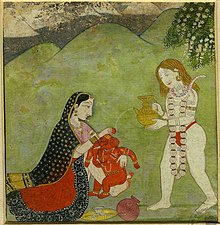

.jpg/220px-Ganesh_(mus%C3%A9e_d'art_asiatique_de_Berlin).jpg)
